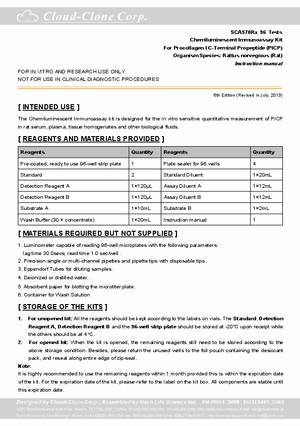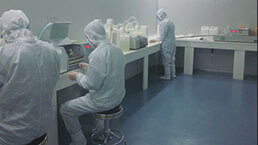Packages (Simulation)

Reagent Preparation

Image (I)
Image (II)
Certificate


CLIA Kit for Procollagen I C-Terminal Propeptide (PICP)
P1CP; C-Propeptide Of Type I Procollagen; Procollagen I Carboxy Terminal Propeptide
- Product No.SCA570Ra
- Organism SpeciesRattus norvegicus (Rat) Same name, Different species.
- Sample TypeSerum, plasma, tissue homogenates and other biological fluids.
- Test MethodDouble-antibody Sandwich
- Assay Length2h, 40min
- Detection Range0.21-150ng/mL
- SensitivityThe minimum detectable dose of this kit is typically less than 0.09ng/mL.
- DownloadInstruction Manual
- UOM 48T96T 96T*5 96T*10 96T*100
- FOB
US$ 638
US$ 912
US$ 4104
US$ 7752
US$ 63840
For more details, please contact local distributors!
Specificity
This assay has high sensitivity and excellent specificity for detection of Procollagen I C-Terminal Propeptide (PICP).
No significant cross-reactivity or interference between Procollagen I C-Terminal Propeptide (PICP) and analogues was observed.
Recovery
Matrices listed below were spiked with certain level of recombinant Procollagen I C-Terminal Propeptide (PICP) and the recovery rates were calculated by comparing the measured value to the expected amount of Procollagen I C-Terminal Propeptide (PICP) in samples.
| Matrix | Recovery range (%) | Average(%) |
| serum(n=5) | 79-103 | 85 |
| EDTA plasma(n=5) | 82-97 | 88 |
| heparin plasma(n=5) | 85-101 | 90 |
Precision
Intra-assay Precision (Precision within an assay): 3 samples with low, middle and high level Procollagen I C-Terminal Propeptide (PICP) were tested 20 times on one plate, respectively.
Inter-assay Precision (Precision between assays): 3 samples with low, middle and high level Procollagen I C-Terminal Propeptide (PICP) were tested on 3 different plates, 8 replicates in each plate.
CV(%) = SD/meanX100
Intra-Assay: CV<10%
Inter-Assay: CV<12%
Linearity
The linearity of the kit was assayed by testing samples spiked with appropriate concentration of Procollagen I C-Terminal Propeptide (PICP) and their serial dilutions. The results were demonstrated by the percentage of calculated concentration to the expected.
| Sample | 1:2 | 1:4 | 1:8 | 1:16 |
| serum(n=5) | 96-103% | 84-99% | 99-105% | 78-94% |
| EDTA plasma(n=5) | 88-95% | 98-105% | 90-98% | 78-91% |
| heparin plasma(n=5) | 97-104% | 81-93% | 81-97% | 92-99% |
Stability
The stability of kit is determined by the loss rate of activity. The loss rate of this kit is less than 5% within the expiration date under appropriate storage condition.
To minimize extra influence on the performance, operation procedures and lab conditions, especially room temperature, air humidity, incubator temperature should be strictly controlled. It is also strongly suggested that the whole assay is performed by the same operator from the beginning to the end.
Reagents and materials provided
| Reagents | Quantity | Reagents | Quantity |
| Pre-coated, ready to use 96-well strip plate | 1 | Plate sealer for 96 wells | 4 |
| Standard | 2 | Standard Diluent | 1×20mL |
| Detection Reagent A | 1×120µL | Assay Diluent A | 1×12mL |
| Detection Reagent B | 1×120µL | Assay Diluent B | 1×12mL |
| Substrate A | 1×10mL | Substrate B | 1×2mL |
| Wash Buffer (30 × concentrate) | 1×20mL | Instruction manual | 1 |
Assay procedure summary
1. Prepare all reagents, samples and standards;
2. Add 100µL standard or sample to each well. Incubate 1 hours at 37°C;
3. Aspirate and add 100µL prepared Detection Reagent A. Incubate 1 hour at 37°C;
4. Aspirate and wash 3 times;
5. Add 100µL prepared Detection Reagent B. Incubate 30 minutes at 37°C;
6. Aspirate and wash 5 times;
7. Add 100µL Substrate Solution. Incubate 10 minutes at 37°C;
8. Read RLU value immediately.
GIVEAWAYS
INCREMENT SERVICES
| Magazine | Citations |
| Nutrition | Dyslipidemic high-fat diet affects adversely bone metabolism in mice associated with impaired antioxidant capacity ScienceDirect: S0899900709004717 |
| American Heart Journal | Serum markers of deranged myocardial collagen turnover: their relation to malignant ventricular arrhythmias in cardioverter-defibrillator recipients with heart failure. PubMed: 23067911 |
| Journal of Hypertension | Circulating biomarkers of collagen metabolism in arterial hypertension: relevance of target organ damage Pubmed: 23615327 |
| Pancreatology | Cdkn1a is a key mediator of rat pancreatic stellate cell senescence Pubmed: 23719597 |
| The American Journal of Cardiology | Relation of burden of myocardial fibrosis to malignant ventricular arrhythmias and outcomes in Fabry disease Pubmed:25073565 |
| PLoS One. | An NMR Metabolomic Study on the Effect of Alendronate in Ovariectomized Mice Pubmed:25184758 |
| Journal of Bone and Mineral Research | The Anti-Osteoanabolic Function of Sclerostin is Blunted in Mice Carrying a High Bone Mass Mutation of Lrp5 Pubmed:25640331 |
| Bone | The active role of osteoporosis in the interaction between osteoblasts and bone metastases PubMed: 26057367 |
| J Nutr Biochem | Consumption of vitamin D2 PubMed: 25792284 |
| Bibliothekssystem Universität Hamburg | Bilaterale Kommunikation zwischen Osteoblasten und Osteoklasten volltexte:2016 |
| Inflammation Research | Fibrosis of extracellular matrix is related to the duration of the disease but is unrelated to the dynamics of collagen metabolism in dilated cardiomyopathy pubmed:27516211 |
| Heart & Vessels | Left ventricular reverse remodeling is not related to biopsy-detected extracellular matrix fibrosis and serum markers of fibrosis in dilated cardiomyopathy, regardless of the definition used for LVRR pubmed:28004175 |
| Scandinavian Journal of Rheumatology | The association between insulin-like growth factor 1 (IGF-1), IGF-binding proteins (IGFBPs), and the carboxyterminal propeptide of type I procollagen (PICP) in pre- and postmenopausal women with rheumatoid arthritis. pubmed:27775453 |
| Allergy and Asthma Proceedings | Effect of montelukast on markers of airway remodeling in children withasthma. pubmed:27657514 |
| Scandinavian Journal of Rheumatology | The association between insulin-like growth factor 1 (IGF-1), IGF-binding proteins (IGFBPs), and the carboxyterminal propeptide of type I procollagen (PICP) in pre- and postmenopausal women with rheumatoid arthritis loi:irhe20 |
| Conditional Mouse Models Support the Role of SLC39A14 (ZIP14) in Hyperostosis Cranialis Interna and in Bone Homeostasis ISBN: 978-94-6299-582-6 | |
| MOLECULAR MEDICINE REPORTS | Endothelial‑to‑mesenchymal transition in human idiopathic dilated cardiomyopathy pubmed:29115553 |
| Pediatrics and Neonatology | Age-related changes in biochemical bone profile in thalassemic children pubmed:28967496 |
| Heart and Vessels | Left ventricular reverse remodeling is not related to biopsy‑detected extracellular matrix fibrosis and serum markers of fibrosis in dilated cardiomyopathy, regardless of the definition used for LVRR 10.1007/s00380-016-0930-y |
| Journal of Bone and Mineral Research | The Lrp4 R1170Q homozygous knock‐in mouse recapitulates the bone phenotype of sclerosteosis in humans pubmed:28477420 |
| Cytokine | 12-month patterns of serum markers of collagen synthesis, transforming growth factor and connective tissue growth factor are similar in new-onset and chronic dilated cardiomyopathy in patients both with and without cardiac fibrosis. pubmed:28460256 |
| Advanced Healthcare Materials | Prognostic value of fibrosis-related markers in dilated cardiomyopathy: A link between osteopontin and cardiovascular events. pubmed:29120858 |
| Journal of Bone and Mineral Metabolism | Mutations That Alter the Carboxy‐Terminal‐Propeptide Cleavage Site of the Chains of Type I Procollagen Are Associated With a Unique Osteogenesis Imperfecta … Pubmed:29669177 |
| Cardiovascular Journal of Africa | Assessment of myocardial fibrosis by late gadolinium enhancement imaging and biomarkers of collagen metabolism in chronic rheumatic mitral regurgitation. Pubmed:29443354 |
| Journal of Cellular Physiology | DNA methylation regulates α‐smooth muscle actin expression during cardiac fibroblast differentiation Pubmed: 30362530 |
| International Journal of Chronic Obstructive Pulmonary Disease | Altered serum levels of type I collagen turnover indicators accompanied by IL-6 and IL-8 release in stable COPD Pubmed: 30655663 |
| Scientific Reports | Low fibrosis biomarker levels predict cardiac resynchronization therapy response Pubmed: 30988339 |
| Bone | Agonist-induced activation of the S1P receptor 2 constitutes a novel osteoanabolic therapy for the treatment of osteoporosis in mice Pubmed: 31028959 |
| PLoS One | Deficiency of sphingosine-1-phosphate receptor 3 does not affect the skeletal phenotype of mice lacking sphingosine-1-phosphate lyase Pubmed: 31314788 |
| Bone | Mice lacking plastin-3 display a specific defect of cortical bone acquisition Pubmed: 31678489 |
| Journal of Diabetes Research | Type 2 Diabetes Mellitus and Chronic Heart Failure with Midrange and Preserved Ejection Fraction: A Focus on Serum Biomarkers of Fibrosis Pubmed: 33224989 |
| JOURNAL OF BONE AND MINERAL RESEARCH | Piezo1 Inactivation in Chondrocytes Impairs Trabecular Bone Formation Pubmed: 33180356 |
| Microbiome changes in patients with chronic heart failure with preserved ejection fraction correlate with fibrosis markers: Description of a Russian cohort | |
| Ассоциации толщины эпикардиального жира и циркулирующих маркеров фиброза миокарда у пациентов с инфарктом миокарда | |
| Russian Journal of Cardiology | Early diagnosis of myocardial fibrosis in patients with epicardial obesity |
| J Diabetes Res | Association between Markers of Fibrosis and Heart Failure Incidence in Patients with Type 2 Diabetes Mellitus 34778465 |
| Clinical, Cosmetic and Investigational Dermatology | Extra Cellular Matrix Deposition and Assembly in Dermis Spheroids 34321901 |
| Scandinavian Cardiovascular Journal | Dual integrin αvβ3 and αvβ5 blockade attenuates cardiac dysfunction by reducing fibrosis in a rat model of doxorubicin-induced cardiomyopathy 34296634 |
| Eur J Appl Physiol | Effects of 8-week increment aerobic exercise program on bone metabolism and body composition in young non-athletes Pubmed:35141785 |
| J. Clin. Med | Simple Predictors for Cardiac Fibrosis in Patients with Type 2 Diabetes Mellitus: The Role of Circulating Biomarkers and Pulse Wave Velocity Pubmed:35628969 |
| Catalog No. | Related products for research use of Rattus norvegicus (Rat) Organism species | Applications (RESEARCH USE ONLY!) |
| SEA570Ra | ELISA Kit for Procollagen I C-Terminal Propeptide (PICP) | Enzyme-linked immunosorbent assay for Antigen Detection. |
| SCA570Ra | CLIA Kit for Procollagen I C-Terminal Propeptide (PICP) | Chemiluminescent immunoassay for Antigen Detection. |
| LMA570Ra | Multiplex Assay Kit for Procollagen I C-Terminal Propeptide (PICP) ,etc. by FLIA (Flow Luminescence Immunoassay) | FLIA Kit for Antigen Detection. |












